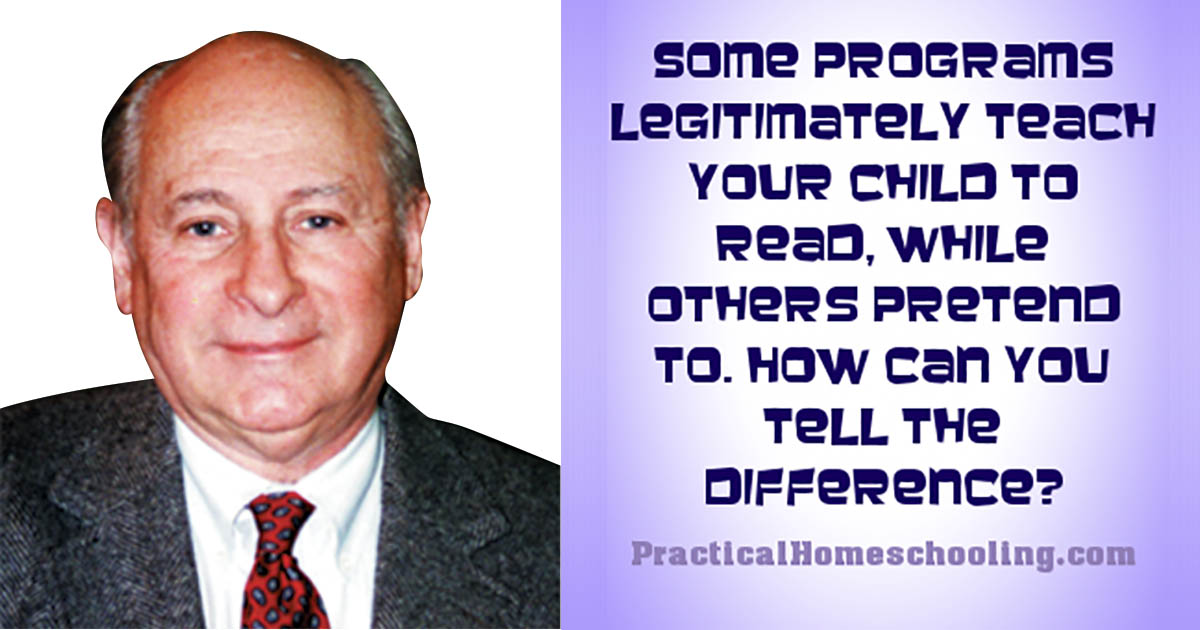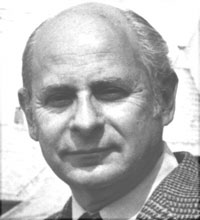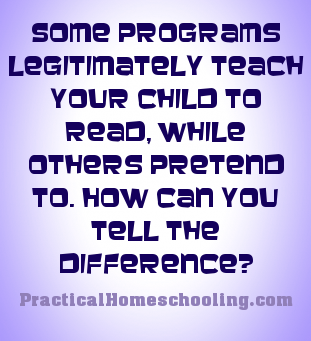How to Tell Real from Phony Phonics?
By Sam Blumenfeld
Printed in Practical Homeschooling #40, 2001.
 How to tell whether a program will really teach your child to read, or just pretend to.
How to tell whether a program will really teach your child to read, or just pretend to.

|
 |
 A lot of parents these days are concerned about how their children are being taught to read in school. And so they ask the teacher, "Are you teaching phonics?" Virtually every primary school teacher in America will say, "Yes, we do teach phonics," after which the parent will go home satisfied and reassured that his or her child will be taught phonics. But, unfortunately, the parent has asked the wrong question. The question that should be asked is, "Do you teach a sight vocabulary?" And again virtually every teacher will answer yes.
A lot of parents these days are concerned about how their children are being taught to read in school. And so they ask the teacher, "Are you teaching phonics?" Virtually every primary school teacher in America will say, "Yes, we do teach phonics," after which the parent will go home satisfied and reassured that his or her child will be taught phonics. But, unfortunately, the parent has asked the wrong question. The question that should be asked is, "Do you teach a sight vocabulary?" And again virtually every teacher will answer yes.
What that answer means is that that teacher's philosophy of reading instruction is based on a whole-word approach and that when phonics is taught in that context it is taught as "phonetic clues" along with picture clues, configuration clues, and context clues.
A child who is taught real phonics does not need all of those "clues" in order to read. Real phonics helps a child develop a phonetic reflex, an automatic ability to translate letters into sounds and the ability to see the phonetic structure of a word.
However, when a child is taught a sight vocabulary, he or she is being forced to look at printed words as whole configurations, like Chinese characters.
Suppose you were asked to memorize 100 Chinese characters. How would you go about doing it? You would try to remember something about each character's shape that would remind you of its meaning.
Kids Don't Discover Phonics When Taught Sight Words
The idea that a child will acquire a knowledge of phonics on his own after having been taught to read holistically is false. It doesn't happen, because the child has developed a holistic reflex, the automatic habit of looking at all words by their whole configurations. In fact, the holistic reflex is an obstacle to seeing a word's phonetic structure. And that is why it sometimes takes years to convert a disabled holistic reader into a fluent phonetic reader.
A study was done in Chicago in 1912 to determine what strategies children who have not received phonics instruction use to attempt to read. Here are some of its conclusions:
"The comments and questions, as well as the misreadings, seem to show that children learn to read words by the trial and error method. It may be the length of the word, the initial letter, the final letter, a characteristic letter, the position of the word in the sentence, or even the blackness of the type that serves as the cue. . . . There is no evidence in any of the cases studied that the child works out a system by which he learns to recognize the words. That he does not work out phonics by himself comes out quite clearly in the transposition test. Furthermore, only once did a child divide a word even into its syllables." ("Learning to Read," Josephine Bowden, Elem. Sch. Teacher, Vol. 12.)
Phony Phonics = "Clues"
So that's what children do in trying to memorize sight words. The teacher will teach some letter sounds, generally initial or final consonant sounds, in order to give the child some clue as to what the word means. Thus, if the word begins with an h as in horse, it couldn't be salami which begins with an s. These are phonetic clues, or phonetic information, as opposed to true phonics instruction.
You can't develop a phonetic reflex with just phonetic information. That information may or may not be used by the student. It is not automatic, and requires effort by the student. That is why so much of the phonetic information children get in whole-word instruction is useless. The reader will prefer to rely on context, for teachers are pleased when a child reads dad for father or pony for horse. So much for phonetic clues.
Holistic readers are easy to spot. They generally don't like to read, but when they do, they leave out words that are there, put in words that aren't there, truncate words, guess at words, misread words.
Real Phonics, Not Dribs & Drabs
Real phonics is intensive, systematic phonics taught prior to reading whole words. Phony phonics is "phonetic clues," provided in the context of a whole-word reading program.
If you want to convert a holistic reader into a phonetic reader, use an intensive phonics system such as mine. Teach your child the entire phonetic system: the consonants, the short vowel sounds, digraphs, diphthongs, etc. Then have him apply his new phonetic knowledge to reading text. Have him read aloud to you. Stop him when he makes a typical holistic error, and have him reread the sentence until he becomes aware of the error he has made. Have him write down all of the new words he has learned, dividing them into syllables so that he can see the phonetic structure of the word and can sound it out. In time, your child will replace his holistic habits with a phonetic reflex. With patience and love your child will be able to achieve success.